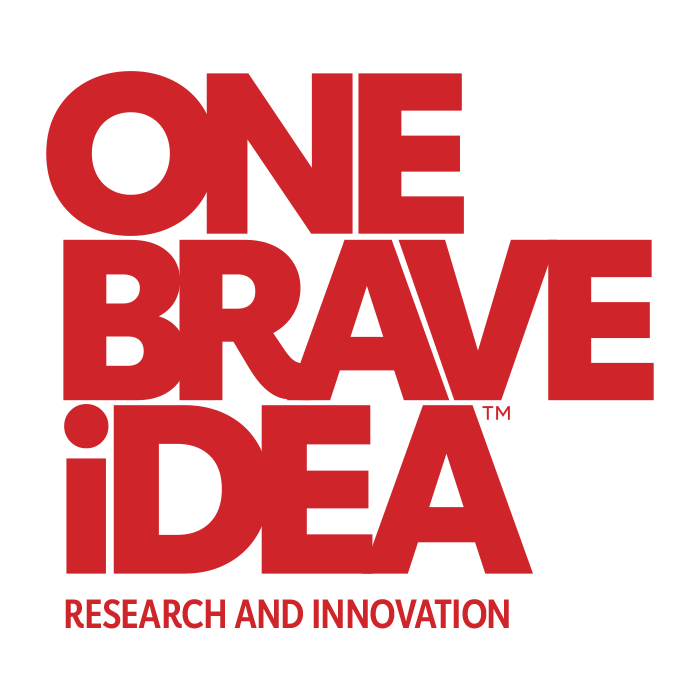By AMERICAN HEART ASSOCIATION NEWS
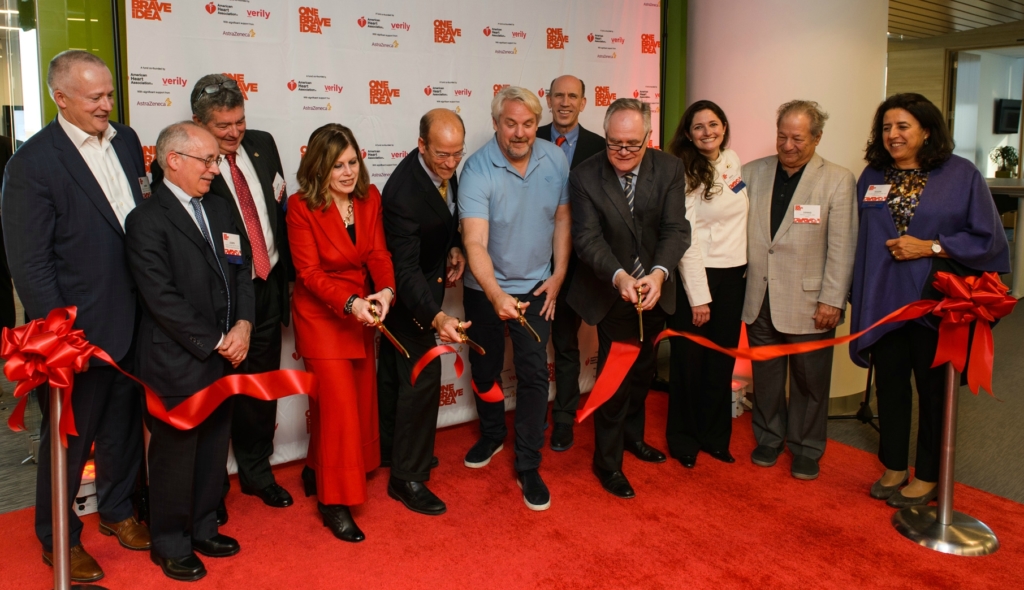
AHA CEO Nancy Brown (in red), Greg Keenan of AstraZeneca, Andy Conrad of Verily and One Brave Idea leader Calum MacRae cut the ribbon on the One Brave Idea Science Innovation Center.
BOSTON – With four pairs of oversized gold scissors snipping a wide red ribbon, the One Brave Idea Science Innovation Center officially opened for business Tuesday.
That business: Finding a new way to solve the age-old problem of heart disease.
One Brave Idea is a $75 million research enterprise that is attacking the No. 1 killer in the world in ways that haven’t been tried. The project itself is a bit of an experiment because of how much it upends the typical formula for scientific research.
Instead of giving a smaller amount of money for one institution to seek incremental progress, the American Heart Association, Verily and biopharmaceutical company AstraZeneca each contributed $25 million and their other vast resources to support a team of specialists from various backgrounds and institutions. The team is overseen by a single leader and guided by his overarching vision.
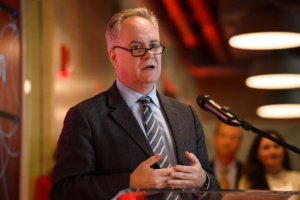
One Brave Idea leader Calum MacRae at the innovation center opening Tuesday.
The leader is Calum MacRae and his vision is essentially creating an “early warning system.” He wants to figure out the causes of heart disease long before any symptoms appear. While that may seem like prevention, he considers it a precursor to that.
“What we’re really doing is moving from prevention back to that boundary of where heart disease first develops,” said MacRae, the chief of cardiovascular medicine at Brigham and Women’s Hospital, one of the core training hospitals for Harvard Medical School. “If we can identify those first transitions, we can maintain wellness longer.”
[Calum MacRae: The man behind the $75 million bid to wipe out coronary heart disease]
One Brave Idea’s focus is coronary heart disease, which is the buildup of plaque inside the arteries that keep a heart pumping. Too much plaque can block an artery, cutting off blood flow; that’s a heart attack. Coronary heart disease is the most common cardiovascular disease.
MacRae is eager to examine areas scientists have never considered as possible clues to heart problems, such as the skin. He’s also using new tools, ranging from those his team creates to those that exist but have never been used to study cardiovascular diseases.
“We look at One Brave Idea almost like a startup company,” said Nancy Brown, CEO of the American Heart Association and chair of One Brave Idea’s oversight committee. “It’s really helping us at this critical intersection of technology and science to find cures for patients and hope for families.”
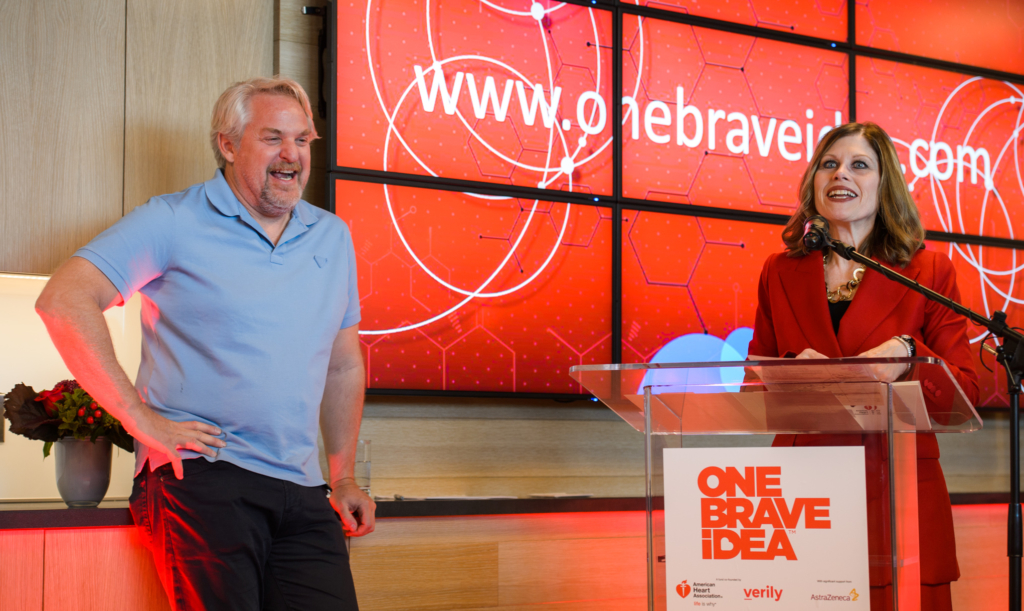
AHA CEO Nancy Brown and Verily CEO Andy Conrad at the One Brave Idea Science Innovation Center.
One Brave Idea experiments are already under way at clinics and labs around Boston and across North America. Think of those locations as the spokes of a wheel; that makes the Science Innovation Center the hub.
Located on the seventh floor of the Longwood Center, a state-of-the-art life sciences building in Boston’s medical research area, the environment features what you’d expect in a modern office. But there’s a unique vibe to it, a sense that Verily CEO Andy Conrad described as being “Google-esque.”
“There’s an energy here you can just feel,” said Greg Keenan, AstraZeneca’s U.S. Head Medical Officer and a member of the project’s oversight committee. “This space actually represents the innovative nature that One Brave Idea is in general.”
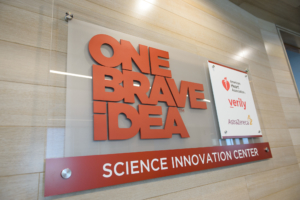 MacRae, Chief Scientific Officer Stan Shaw and others have offices at the headquarters. There are a variety of conference rooms and workspaces of all sizes.
MacRae, Chief Scientific Officer Stan Shaw and others have offices at the headquarters. There are a variety of conference rooms and workspaces of all sizes.
“This center provides an opportunity for the scientists, researchers, young investigators, mathematicians and data scientists who are all working together to find an end to coronary heart disease to have a single location where they can collaborate, while also recognizing and appreciating the virtual nature of the team,” Brown said.
MacRae had been thinking about an early warning system for years, but doubted he’d have a chance to explore it – mainly because of how different it is from traditional research. Then this enterprise was announced in November 2015.
Last summer, MacRae was picked over 348 other applicants and immediately went to work.
[Calum MacRae receives $75 million to pursue ‘One Brave Idea’ to beat coronary heart disease]
He built a team of scientists, mathematicians, engineers and even a venture capitalist. They came up with all sorts of pilot projects and went into them with the technology world’s approach of being willing to fail fast and move on to the next-best thing.
Three projects are far enough along to be on display Tuesday evening. Each showcases One Brave Idea’s powerful potential:
- The clinic visit of the future – Survivors of stroke and other traumatic injuries already use motion sensors strapped around their wrists and ankles to evaluate their balance and gait (how they walk). Diabetes patients already use a device that examines the sweat glands on their hands and feet. These tests are quick and simple to perform – and may offer insights into heart disease, too. They could eventually be given by a cardiologist or as part of an annual physical.
- The tool of the future – Take all the information gathered from existing wearable devices and add constant monitoring of hundreds of biomarkers in your body. The amount of information it could gather is staggering; so is the immediate feedback it could provide, such as an alert on your watch that you’re having a heart attack.
- The tests and medicines of the future – This is perhaps the most traditional element (seeking new tests to run and medicines that can treat problems), although it’s being done in a non-traditional way: Using zebrafish, tiny black-and-white fish with cardiovascular systems and genetics similar to humans that also have see-through exteriors, which makes it easier to study how they respond to diets and chemicals. They’ve been used in this field before (most notably by MacRae), but never to this extent.
MacRae, Brown, Keenan and Conrad participated in the ceremonial ribbon cutting. The event was attended by more than 100 people, including pioneering cardiology researcher Eugene Braunwald and Betsy Nabel, president of Brigham and Women’s Hospital.
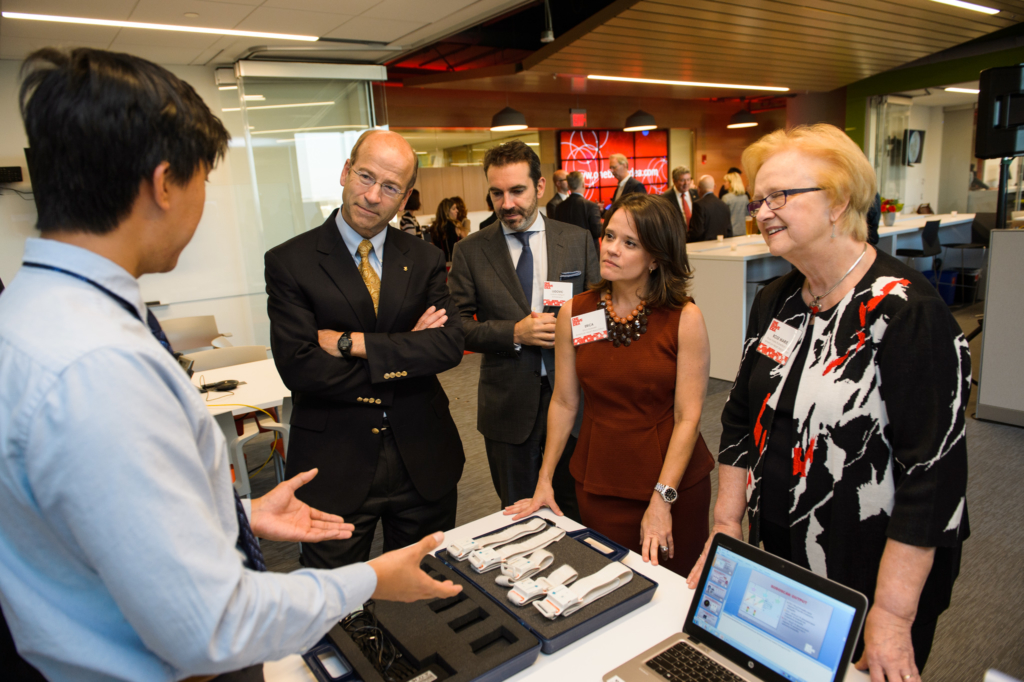
Ximou Song explains how motion sensors are being studied as a tool for heart disease. His audience includes Greg Keenan of AstraZeneca (arms crossed) and Rose Marie Robertson, AHA’s Chief Science and Medical Officer (far right).
Keenan said many guests came without knowing what to expect, or expecting something typical for the launch of a typical research undertaking.
“They were actually taken aback by the space and the enthusiasm,” he said. “The fact they stuck around to learn at the different research areas showed that they were impressed as well.”
The AHA’s $25 million investment is its largest in a single science project in the organization’s 93-year history. That’s even more significant considering the AHA is the second-largest funder of cardiovascular research, behind only the federal government. The organization has spent more than $4.1 billion on research, including more than $100 million annually since 1996.
“Through One Brave Idea, we will find new discoveries that will move us closer to ending coronary heart disease and its devastating consequences, and we will change the way research is conducted in this country,” Brown said. “Boy, what a legacy to leave.”
If you have questions or comments about this article, please email [email protected].
